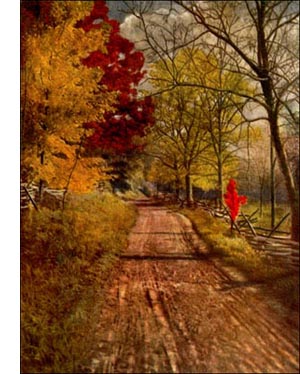Red Ash Tree
 Red Ash (Fraxinus Pennsylvanica, Marsh.)-A small, spreading tree, 40 to 60 feet high, with irregular, compact head of twiggy branches. Bark reddish, closely furrowed, scaly; young twigs pubescent. Buds small, dark brown, nodes close together.
Red Ash (Fraxinus Pennsylvanica, Marsh.)-A small, spreading tree, 40 to 60 feet high, with irregular, compact head of twiggy branches. Bark reddish, closely furrowed, scaly; young twigs pubescent. Buds small, dark brown, nodes close together. leaves 10 to 12 inches long, of 7 to 9 leaflets, lanceolate, coarsely serrate. on short stalks, smooth, yellow-green above, silvery pubescence on petioles and leaf linings; yellow in fall. Flowers, May, with leaves; dioecious, in hairy panicles; pistillate greenish, inconspicuous.
Fruit slender, clustered keys, 1 to 2 inches long, on hairy stems; wing 1 inch long and extending half way around the body. Preferred habitat, moist soil near streams or lakes. Distribution, New Brunswick to Ontario and the Black Hills in Dakota; south to Florida, Alabama and Nebraska, Uses: Inferior to white ash in all ways. Often planted in eastern United States for shade and ornament.
The red ash thrives best in the Northeastern States, especially in Pennsylvania. West of the Alleghanies it is an inferior tree. Its lumber is of poor quality compared with white ash, but being of the same colour it is often substituted for the latter by unscrupulous lumber dealers.
The common name of this species probably refers to the red inner layer of the outer bark of the branches. This trait alone is not a distinguishing one, however, for white ash sometimes shows the same character. The red ash has velvety down that invests its new shoots. Winter and summer, this sign never fails.
The tree has slimmer twigs and branches than most of the ashes, and crowds its buds and twigs much more closely. The silky leaf linings lighten and soften the yellow-green foliage mass. Red-ash seeds are extremely slender, and vary in size and form, the most graceful in outline of all the darts the various ash trees bear. Lingeringly the tree gives up its seeds in winter.
A breeze strong enough to tear off a few from the cluster will carry them a considerable distance. The heavy body or seed end of a key pitches downward, but tire thin wing gives the wind a chance to lift it. So on its dainty sail the seed is borne away to plant an ash far from the parent tree, if by chance it fall in good ground.
It is easy to understand why ash trees always grow scattered here and there through the woods. Go out on a winter day when the wind blows a gale and see the pistillate tree launching its seeds. It is worth a journey and some discomfort to see it.